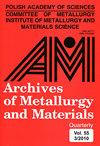激光焊缝弯曲路径对 6063 铝合金强度和温度分布的影响:COMSOL 数值模拟
IF 0.7
4区 材料科学
Q4 METALLURGY & METALLURGICAL ENGINEERING
引用次数: 0
摘要
为提高铝合金的焊接性能,建立了不规则焊缝的热源模型。利用 COMSOL 软件对激光焊接中焊缝几何形状对温度场和应力场的影响进行了数值模拟,并对结果进行了实验验证。结果表明,椭圆形激光焊接熔化微池表现出准稳态温度场特征。温度梯度和热应力呈先上升后下降的趋势。方齿形焊缝的温度波动幅度超过了弧齿形焊缝。除拐点外,断线齿形焊缝的温度变化呈轻微上升趋势。焊缝的实验平均抗拉强度最高,达到约 210 兆帕,约为母材(245 兆帕)的 85%,这与基于 COMSOL 的温度场模拟结果相吻合。随着变形幅度和过渡半径的增大,最大拉伸力、拉伸强度和断裂伸长率呈上升趋势。但变形幅度应低于一定限度,因为变形幅度的增大会拉长焊接路径,减小焊缝间距,导致严重的热积累。6063-T6 母材的拉伸断口形态为弧形剪切,韧性凹坑较浅,边缘有小的撕裂边,并有小的颗粒状物体,表明断裂过程中塑性变形较小。焊接件的拉伸断裂跨越焊缝和母材,断裂沿焊缝的切线方向发生。断口表面光滑,韧性凹坑边缘的撕裂边缘沿焊缝方向移动,形成许多共向滑移带,塑性变形非常明显。本文章由计算机程序翻译,如有差异,请以英文原文为准。
Laser Weld Seam Curved Path Effect on 6063 Aluminum Alloy Strength and Temperature Distributions: COMSOL Numerical Simulation
To improve the welding performance of aluminum alloys, a thermal source model of an irregular weld seam was established. COMSOL software was used for numerical simulation of the weld seam geometry effect on the temperature and stress fields in laser welding, which results were experimentally validated. The results show that the ellipsoidal laser welding melted micropool exhibited quasi-steady-state temperature field characteristics. The temperature gradient and thermal stress showed an increase followed by a decline. The temperature fluctuation amplitude of the square-tooth-shaped weld seam exceeded that of the arc-toothshaped one. The temperature evolution of the broken line tooth-shaped weld seam showed a slightly increasing trend, except for the inflection point. The experimental average tensile strength of the weld seam was the highest, reaching about 210 MPa, i.e., roughly 85% of the base material (245 MPa), which coincided with the COMSOL-based temperature field simulation results. With increasing deformation amplitude and transition radius, the maximum tensile force, tensile strength, and elongation at fracture showed an increasing trend. However, the deformation amplitude should be below a certain limit because its increase elongates the welding path and reduces the distance between weld seams, resulting in serious heat accumulation. The tensile fracture morphology of the 6063-T6 base material was curved shear, with shallow toughness pits, small tearing edges at the edges, and small granular objects, indicating small plastic deformation during the fracture process. The tensile fracture of the welded part spanned the weld seam and the base material, and the fracture occurred along the tangent direction of the weld seam. The fracture surface was smooth, the tearing edges at the edge of the toughness pit shifted along the weld seam direction, forming many co-directional slip bands, with highly pronounced plastic deformation.
求助全文
通过发布文献求助,成功后即可免费获取论文全文。
去求助
来源期刊

Archives of Metallurgy and Materials
工程技术-冶金工程
CiteScore
1.20
自引率
0.00%
发文量
0
审稿时长
4.5 months
期刊介绍:
The Archives of Metallurgy and Materials is covered in the following Institute for Scientific Information products: SciSearch (the Science Citation Index - Expanded), Research Alert, Materials Science Citation Index, and Current Contents / Engineering, Computing and Technology.
Articles published in the Archives of Metallurgy and Materials are also indexed or abstracted by Cambridge Scientific Abstracts.
 求助内容:
求助内容: 应助结果提醒方式:
应助结果提醒方式:


